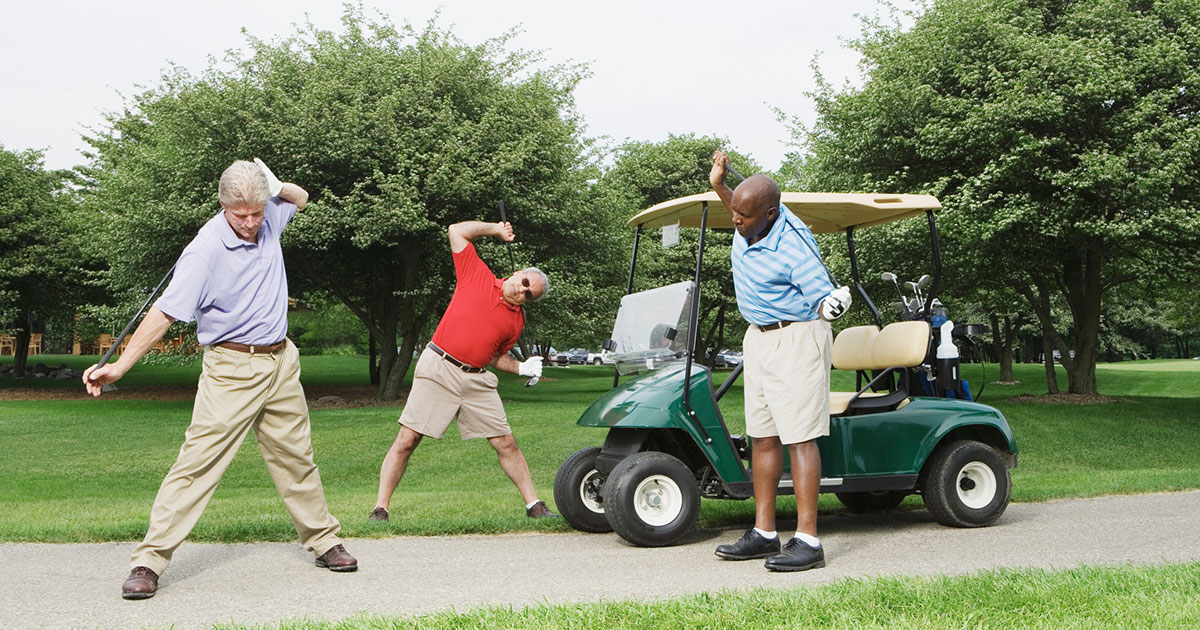Golfers, like any athletes, can face a variety of health issues, some specific to their sport and others common among athletes in general. Here are some potential health concerns for golfers and tips to protect themselves:
Back Pain: The repetitive motion of swinging a golf club can strain the back muscles and spine, leading to pain or injury. To protect against back issues, golfers should focus on maintaining proper posture and technique, warming up before playing, and incorporating exercises to strengthen the core and back muscles.
Shoulder Injuries: The rotational movement of the golf swing can put stress on the shoulders, leading to issues such as rotator cuff injuries or tendonitis. Golfers should ensure they have proper swing mechanics, avoid overexertion, and incorporate shoulder-strengthening exercises into their fitness routine.
Elbow Pain: Golfers may experience pain in the elbows, commonly known as golfer’s elbow (medial epicondylitis) or tennis elbow (lateral epicondylitis), due to repetitive swinging motions. Proper warm-up, stretching, and strengthening exercises can help prevent these injuries.
Wrist and Hand Injuries: The grip and repetitive impact of hitting the ball can lead to wrist and hand injuries such as sprains, strains, or tendonitis. Using proper grip technique, warming up before playing, and strengthening the wrists and hands can help prevent these injuries.
Foot and Ankle Injuries: Walking long distances on uneven terrain and making repetitive motions during the swing can lead to foot and ankle injuries. Wearing proper golf shoes with good support and traction, stretching before playing, and paying attention to any signs of discomfort can help prevent these injuries.
Sun Exposure: Spending long hours on the golf course exposes players to the sun’s harmful UV rays, increasing the risk of skin damage and skin cancer. Golfers should protect themselves by wearing sunscreen, hats, sunglasses, and seeking shade when possible.
Dehydration: Golf is often played outdoors in warm weather, increasing the risk of dehydration, especially if players fail to drink enough water during their round. Staying hydrated before, during, and after play is essential for maintaining performance and preventing heat-related illnesses.
Overuse Injuries: Golf involves repetitive motions, which can lead to overuse injuries in various parts of the body, including the wrists, elbows, shoulders, and back. To prevent overuse injuries, golfers should incorporate rest days into their schedule, cross-train with other activities, and listen to their bodies to avoid pushing through pain.

Stretches that will Improve Flexibility
Before playing golf, it’s essential for golfers to perform stretches that target the muscles used in the golf swing and help improve flexibility and range of motion. Here are some recommended stretches for golfers, along with their sources:
Trunk Rotations: Stand with feet shoulder-width apart.
Hold a club or golf club behind your neck with both hands.
Rotate your torso to the right and then to the left, keeping your lower body stable. Perform 10-15 repetitions on each side.1
Shoulder Stretch: Hold a club or golf club in your left hand.
Bring your left arm across your chest. Use your right hand to gently press your left arm closer to your chest. Hold for 15-30 seconds and then switch arms.2
Hamstring Stretch: Stand with feet shoulder-width apart. Extend one leg straight in front of you with your heel on the ground and toes pointing up. Hinge at the hips and lean forward, keeping your back straight until you feel a stretch in the back of your thigh. Hold for 15-30 seconds and then switch legs.3
Hip Flexor Stretch: Kneel on your right knee with your left foot in front of you, knee bent at a 90-degree angle. Lean forward, shifting your weight onto your left leg, until you feel a stretch in the front of your right hip. Hold for 15-30 seconds and then switch sides.⁴
Wrist Flexor Stretch: Extend one arm in front of you with palm facing down. Use your other hand to gently press the fingers of your extended hand downward until you feel a stretch in your forearm and wrist. Hold for 15-30 seconds and then switch arms.⁵
Calf Stretch: Stand facing a wall with hands against the wall at shoulder height. Step back with one foot, keeping it straight, and press the heel into the ground. Lean forward into the wall until you feel a stretch in your calf. Hold for 15-30 seconds and then switch legs.⁶
Overall, maintaining good physical conditioning, using proper technique, warming up before playing, staying hydrated, and protecting against sun exposure are essential for golfers to stay healthy and perform at their best. Regular stretching, strength training, and conditioning exercises specific to golf can also help prevent injuries and improve performance. If experiencing persistent pain or discomfort, it’s important for golfers to seek medical advice from a healthcare professional.
©2024HealthSpot References: (1) Mayo Clinic – Golf stretches for a more fluid swing (2) Golf Channel – Golf Fitness: 10 exercises to improve your game (3) American Council on Exercise (ACE) – Golf Flexibility Exercise: Hamstring Stretch (4) Golf Digest – Golf Stretches That Will Improve Your Game (5) GolfWRX – Golf Stretching and Flexibility Exercises (6) Golf Channel – Golf Fitness: 10 exercises to improve your game

